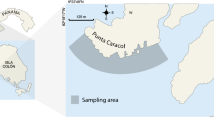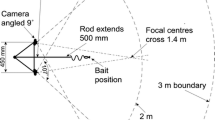Abstract
Blue tangs in Barbados exhibit three distinct social modes: territorial, schooling and wandering. We compared the mobility, foraging, aggression performed and received and the use of cleaning stations of adult blue tangs among modes and among habitats within a single fringing reef in Barbados. Evidence from observed switches during focal observations and multiple observations of tagged individuals indicate that fish are either territorial or non-territorial. Non-territorial fish formed schools and wandered. However, wandering can be used during solitary movements by fish in either type. Fish in the territorial mode, not previously described in adults of this species, restricted activity to a small area overlapping the territories of other tangs. They actively chased conspecifics and were chased mostly by damselfishes. They swam more slowly and fed at higher rates than other modes. Fish in the schooling mode ranged widely in compact, polarized groups of conspecifics, congeners and other species. They were not aggressive and were attacked mostly by damselfishes. They swam rapidly and fed at intermediate rates. Fish in the wanderer mode showed neither aggression nor association with other individuals. They swam rapidly, well above the substrate, fed little, were chased by conspecifics, ocean surgeonfish, A. bahianus, and damselfish and visited cleaning stations more often then other modes. All three modes were observed in all four main zones of the reef, and their behaviour changed quantitatively with habitat type. We suggest that territoriality reduces competition for algal food, schooling allows fish to overcome the food defence by damselfish, tangs and ocean surgeonfish, and wandering permits solitary movement over the reef to cleaning stations, feeding sites and other resources.
Similar content being viewed by others
References
Alevizon, W.S. 1976. Mixed schooling and its possible significance in a tropical western Atlantic parrot fish and surgeon fish. Copeia 1978: 796–798.
Barlow, G.W. 1974a. Extraspecific imposition of social grouping among surgeon fishes (Pisces: Acanthuridae). J. Zool. Lond. 174: 333–340.
Barlow, G.W. 1974b. Contrasts in social behaviour between Central American cichlid fishes and coral-reef surgeon fishes. Am. Zool. 14: 9–34.
Bell, T. & D.L. Kramer. 2000. Territoriality and habitat use by juvenile blue tangs, Acanthurus coeruleus Environ. Biol. Fishes 58: 401–409.
Chapman, M.R. & D.L. Kramer. 2000. Movements of fishes within and among fringing coral reefs in Barbados. Environ. Biol. Fishes 57: 11–24.
Choat, J.H. & D.R. Bellwood. 1985. Interactions amongst herbivorous fishes on a coral reef: influence of spatial variation. Mar. Biol. 89: 221–234.
Choat, J.H. & D.R. Bellwood. 1991. Reef Fishes: their history and evolution. pp39–60. In: P.F. Sale (ed.),The Ecology of Fishes on Coral Reefs, Academic Press, New York.
Colin, P.L. 1977. Spawning of western Atlantic surgeon fishes. Nat. Geogr. Soc. Res. 18: 243–250.
Craig, P. 1996. Intertidal territoriality and time-budget of the surgeon fish, Acanthurus lineatus, in American Samoa. Environ. Biol. Fishes 46: 27–36.
Day, R.W. & G.P. Quinn. 1989. Comparisons of treatments after an analysis of variance in ecology. Ecol. Monogr. 59: 433–463.
DeLoach, N. 1999. Reef Fish Behavior, New World Publications, Verona, 359 pp.
Duarte, S.A. & A. Acero. 1988. Hábitos alimentarios de los peces del género Acanthurus (Perciformes: Acanthuridae) en la region de Santa Marta (Caribe colombiano). Rev. Biol. Trop. 36: 399–405.
Foster, S.A. 1985a. Group foraging by a coral reef fish: a mechanism for gaining access to defended resources. Anim. Behav. 33: 782–792.
Foster, S.A. 1985b. Size-dependent territory defense by a damsel fish: a determinant of resource use by group-foraging surgeon fishes. Oecologia 67: 499–505.
Grant, J.W.A. 1993. Whether or not to defend the influence of resource distribution. Mar. Behav. Physiol. 23: 137–153.
Hiatt, R.W. & D.W. Strastburg. 1960. Ecological relationships of the fauna on coral reefs on the Marshall Islands. Ecol. Monogr.30: 65–127.
Hourigan, T.F. 1986. An experimental removal of a territorial pomacentrid: effects on the occurrence and behaviour of competitors. Environ. Biol. Fishes 15: 161–169.
Itzkowitz, M. 1977. Social dynamics of mixed-species groups of Jamaican reef fishes. Behav. Ecol. Sociobiol.2: 361–384.
Jones, R.S. 1968. Ecological relationships in Hawaiian and Johnston Island Acanthuridae (surgeon fishes). Micronesica 4: 309–361.
Kohda, M. & Y. Takemon. 1996. Group foraging by the herbivorous cichlid fish, Petrochromis fasciolatus, in Lake Tanganyika. Ichthyol. Res. 43: 55–63.
Lawson, G.L.,D.L. Kramer & W. Hunte. 1999. Size-related habitat use and schooling behavior in two species of surgeon fish (Acanthurus bahianus and A. coeruleus) on a fringing reef in Barbados, West Indies. Environ. Biol. Fishes 54: 19–33.
Lewis, J.B. 1960. The coral reefs and coral communities of Barbados,W. I. Can. J. Zool. 38: 1133–1145.
Lewis, J.B. 2002. Evidence from aerial photography of structural loss of coral reefs at Barbados, West Indies. Coral Reefs 21: 49–56.
Lindsey, C.C. 1978. Form, function, and locomotory habits in fish. pp 1–100. In: W.S. Hoar & D.J. Randall (eds.)Fish Physiology,Vol 7, Academic Press.
Marsh, A.C. & A.J. Ribbink. 1986. Feeding schools among Lake Malawi cichlid fishes. Environ. Biol. Fishes 15: 75–79.
Milliken, G.A. & D.E. Johnson. 1984. Analysis of Messy Data Vol. 1: Designed Experiments, Chapman & Hall, London, 473 pp.
Montgomery, W.L.,A.A. Myrberg & L. Fishelson. 1989. Feeding ecology of surgeon fishes (Acanthuridae) in the northern Red Sea, with particular reference to Acanthurus nigrofuscus (Forsskål). J. Exp. Mar. Biol. Ecol. 132: 179–207.
Morgan, I.E. 2003. The behaviour and ecology in social organization of a Caribbean surgeon fish. M.Sc. Thesis, McGill University. 112 pp.
Ogden, J.C. & N.S. Buckman. 1973. Movements, foraging groups, and diurnal migrations of the striped parrot fish, Scarus croicensis Bloch (Scaridae). Ecology 54: 589–596.
Pitcher, T.J. 1986. Functions of fishoaling behaviour in teleosts. pp.294–337. In: T.J. Pitcher (ed.),The Behaviour of Teleost Fishes, Croom Helm, London.
Reeson, P.H. 1975. The biology, ecology and exploitation and management of Caribbean reef fishes; Acanthuridae (Surgeon fishes). Scientific Report of the O.D.A/U.W.I Fisheries Ecology Research Report (1969 –1973) Part V(3).Kingston, Jamaica. 61 pp.
Reinthal, P.N. & S.M. Lewis. 1986. Social behaviour, foraging efficiency and habitat utilization in a group of tropical herbivorous fish.Anim. Behav. 34: 1687–1693.
Roberts, C.M. 1987. Experimental analysis of resource sharing between herbivorous damsel fish and blennies on the Great Barrier Reef. J. Exp. Mar. Biol. Ecol. 111: 61–75.
Robertson, D.R. 1991. Increases in surgeon fish populations after mass mortality of the sea urchin Diadema antillarum in Panamá indicate food limitation. Mar. Biol. 111: 437–444.
Robertson, D.R. & S.D. Gaines. 1986. Interference competition structures habitat use in a local assemblage of coral reef surgeon fishes. Ecology 67: 1372–1383.
Robertson, D.R.,H.P.A. Sweatman, E.A. Fletcher & M.G. Cleland. 1976. Schooling as a mechanism for circumventing the territoriality of competitors. Ecology 57: 1208–1220.
Robertson, D.R,N.V.C. Polunin & K. Leighton. 1979. The behavioural ecology of three Indian Ocean surgeon fish (Acanthurus lineatus, A. leucosternon and Zebrasoma scopes): their feeding strategies, and social and mating systems. Environ. Biol. Fishes 4: 125–170.
Robins, C.R. & G.C.Ray. 1986. A field guide to Atlantic coast fishes of North America, Houghton Mifflin Company, Boston. 354 pp.
Vine, P.J. 1974. Effects of algal grazing and aggressive behaviour of the fishes Pomacentrus lividus and Acanthurus sohal on coral reef ecology. Mar. Biol. 24: 131–136.
Wittenberger, J.F. 1985. Animal Social Behavior, Duxbury Press, Boston, 722 pp.
Author information
Authors and Affiliations
Rights and permissions
About this article
Cite this article
Morgan, I., Kramer, D. The social organization of adult blue tangs, Acanthurus coeruleus, on a fringing reef, Barbados, West Indies. Environmental Biology of Fishes 71, 261–273 (2004). https://doi.org/10.1007/s10641-004-0299-0
Issue Date:
DOI: https://doi.org/10.1007/s10641-004-0299-0




